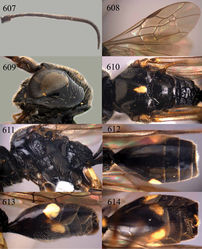Teranishia glabrata
| Notice: | This page is derived from the original publication listed below, whose author(s) should always be credited. Further contributors may edit and improve the content of this page and, consequently, need to be credited as well (see page history). Any assessment of factual correctness requires a careful review of the original article as well as of subsequent contributions.
If you are uncertain whether your planned contribution is correct or not, we suggest that you use the associated discussion page instead of editing the page directly. This page should be cited as follows (rationale):
Citation formats to copy and paste
BibTeX: @article{Chen2014ZooKeys385, RIS/ Endnote: TY - JOUR Wikipedia/ Citizendium: <ref name="Chen2014ZooKeys385">{{Citation See also the citation download page at the journal. |
Ordo: Hymenoptera
Familia: Trigonalyidae
Genus: Teranishia
Name
Teranishia glabrata Chen & van Achterberg & He & Xu, 2014 sp. n. – Wikispecies link – ZooBank link – Pensoft Profile
Type material
Holotype, + (ZJUH) “[China:] Henan, Neixiang, Mt. Baotianman, 15.VII.1998, Yun Ma, 986723”. Paratypes: 1 > (ZJUH), “[China:] Ningxia, Mt. Liupan, Hongxia Forestry Farm, 2.VII.2008, Jing-xian Liu, 200800812”; 1 + (ZJUH), “[China:] Henan, Song County, Mt. Baiyun, 1400 m, 26.VII.2003, Yan-bing Shen, 20047321”; 1 + + 2 > (ZJUH, RMNH), “[China:] Zhejiang, Mt. Tianmu, Xianrending, 1509 m, 1.VII.2001, Mei-hua Piao, 200106405, 200106406; id., but 2.VII.2000, Yun Ma”; 1 + (ZJUH), “[China:] Sichuan, Wolong National Nature Reserve, 21.VII.2006, Hong-ying Zhang, 200610791”.
Diagnosis
Antenna without ivory band subapically (Fig. 607); occipital carina weakly developed and smooth dorsally (Fig. 606); frons strongly shiny and smooth (Fig. 605); scutellum largely smooth, with longitudinal depression and strongly shiny (Fig. 610); mesosoma without pale pattern dorsally, mesoscutum black medially (Fig. 610); third submarginal cell 0.4–0.5 times as long as second submarginal cell; first tergite metasomal black, largely brownish-white or with a reddish-yellow lateral patch apically (Fig. 612); second tergite usually with ivory patch laterally (Fig. 612).
Description
Holotype, female, length of body 7.5 mm (of fore wing 6.8 mm).
Head. Antenna with 20 segments; frons, vertex and temple smooth and shiny (Figs 605, 606, 609); head gradually narrowed behind eyes, eye in dorsal view 1.2 times as long as temple (Fig. 606); occipital carina weakly developed and smooth dorsally (Fig. 606); supra-antennal elevations medium-sized (about 0.4 times as long as scapus), outer side subvertical and obliquely and weakly striate (Fig. 606); clypeus hardly concave and very thick medio-ventrally.
Mesosoma. Length of mesosoma 1.4 times its height (Fig. 611); mesopleuron below transverse mesopleural groove coarsely rugose antero-dorsally and smooth ventrally and posteriorly, above groove coarsely rugose anteriorly and smooth posteriorly; transverse mesopleural groove wide, deep and coarsely crenulate; notauli moderately wide, deep and coarsely crenulate; mesoscutum smooth and strongly shiny, lateral lobe with a narrow and shallow mid-longitudinal furrow (Fig. 610); scutellar sulcus wide, both medially and laterally and coarsely crenulate; scutellum largely smooth, with longitudinal depression and strongly shiny, anteriorly near level of scutellum (Fig. 610); metanotum medially slightly convex, not protruding and smooth (Fig. 610); propodeum irregularly areolate (Fig. 610); posterior propodeal carina thick lamelliform and strongly arched, foramen medially 0.7 times higher than wide basally.
Wings. Fore wing: length of vein 1-M 2.8 times as long as vein 1-SR (Fig. 608).
Metasoma. First tergite 0.4 times as long as apically wide, smooth and with shallow depression antero-medially (Fig. 612); other tergites and sternites smooth to superficially coriaceous and shiny (Figs 612, 614); third sternite about 0.3 times as long as second sternite (Fig. 614); hypopygium triangular in ventral view.
Colour. Head black with short ivory stripes along inner orbita; mesosoma black except for middle lobe with central ivory patch posteriorly; metasoma largely black with large ivory spots on postero-lateral margin of second tergite and sternite; palpi dark brown; mandible black; antenna black; apex of fore femur, tibia and tarsus yellowish brown, outer side of hind coxa, hind trochanter and trochantellus ivory, remainder of legs dark brown to black; pterostigma of fore wing dark brown, remainder of wing membrane subhyaline.
Variation. Length of body 7.0–8.2 mm, of fore wing 5.7–7.0 mm; frons entirely black or with very faint ivory stripes; mesosoma entirely black or with faint and small central ivory patch; ivory spots on second tergite very small and absent on second sternite; outer surface of hind coxa black and all legs darker; length of vein 1-M of fore wing 2.8–3.2 times as long as vein 1-SR.
Male. Length of body 8.0–10.2 mm, of fore wing 6.7–8.1 mm; antenna with 20 segments; genitalia extruded (Fig. 616); otherwise similar to female.
Biology
Unknown. Collected in July at 1400–1509 m.
Distribution
China (Ningxia, Henan, Zhejiang, Sichuan).
Etymology
Named after the largely smooth and shiny frons and scutellum: from “glaber” (Latin for “hairless, bald, smooth”).
Original Description
- Chen, H; van Achterberg, C; He, J; Xu, Z; 2014: A revision of the Chinese Trigonalyidae (Hymenoptera, Trigonalyoidea) ZooKeys, 385: 1-207. doi
Images
|


